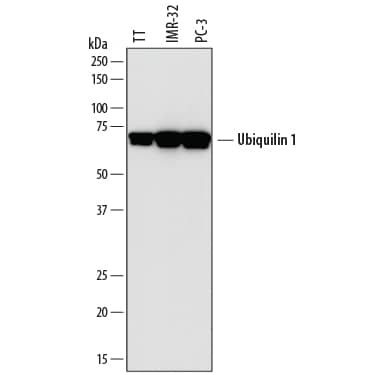Ubiquilin 1 Products
Ubiquilin 1 is a ubiquitously expressed member of the UBL-UBA family of Ubiquitin-binding proteins that is 589 amino acids (aa) in length and has a predicted molecular weight of 62.5 kDa. Human Ubiquilin 1 shares 88% aa sequence identity with the mouse and rat orthologs. It contains an N-terminal Ubiquitin-like (UBL) domain and a C-terminal Ubiquitin-associated (UBA) domain. The UBA domain is able to interact with mono- and poly-Ubiquitin chains, with a similar affinity for Lys48- and Lys63-linked chains. In contrast, the UBL domain interacts with Ubiquitin-interacting motif (UIM)-containing proteins, such as S5a/Angiocidin, a 19S Proteasome component. It is thought that Ubiquilin 1 may act as a molecular shuttle, bringing poly-ubiquitinated proteins to the 26S Proteasome by simultaneously binding poly-Ubiquitin via its UBA domain and the 19S Proteasome via its UBL domain. Ubiquilin 1 also binds two endoplasmic reticulum (ER)-localized proteins, Herp and Erasin, and may function in the ER-associated degradation pathway. It has been reported to co-precipitate with LC3/MAP1LC3A/Apg8p3, an autophagosomal marker, suggesting that it may play a role in autophagy. Single nucleotide polymorphisms in the UBQLN1 gene have been linked to Alzheimer’s disease (AD). Furthermore, Ubiquilin 1 may regulate the processing of APP, which is associated with AD.
8 results for "Ubiquilin 1" in Products
8 results for "Ubiquilin 1" in Products
Ubiquilin 1 Products
Ubiquilin 1 is a ubiquitously expressed member of the UBL-UBA family of Ubiquitin-binding proteins that is 589 amino acids (aa) in length and has a predicted molecular weight of 62.5 kDa. Human Ubiquilin 1 shares 88% aa sequence identity with the mouse and rat orthologs. It contains an N-terminal Ubiquitin-like (UBL) domain and a C-terminal Ubiquitin-associated (UBA) domain. The UBA domain is able to interact with mono- and poly-Ubiquitin chains, with a similar affinity for Lys48- and Lys63-linked chains. In contrast, the UBL domain interacts with Ubiquitin-interacting motif (UIM)-containing proteins, such as S5a/Angiocidin, a 19S Proteasome component. It is thought that Ubiquilin 1 may act as a molecular shuttle, bringing poly-ubiquitinated proteins to the 26S Proteasome by simultaneously binding poly-Ubiquitin via its UBA domain and the 19S Proteasome via its UBL domain. Ubiquilin 1 also binds two endoplasmic reticulum (ER)-localized proteins, Herp and Erasin, and may function in the ER-associated degradation pathway. It has been reported to co-precipitate with LC3/MAP1LC3A/Apg8p3, an autophagosomal marker, suggesting that it may play a role in autophagy. Single nucleotide polymorphisms in the UBQLN1 gene have been linked to Alzheimer’s disease (AD). Furthermore, Ubiquilin 1 may regulate the processing of APP, which is associated with AD.
| Reactivity: | Human |
| Details: | Sheep IgG Polyclonal |
| Applications: | WB |
| Reactivity: | Human, Mouse, Hamster, Chinese Hamster |
| Details: | Rabbit IgG Polyclonal |
| Applications: | WB |
| Reactivity: | Human |
| Details: | Mouse IgG1 kappa Monoclonal Clone #1C6-B7 |
| Applications: | WB, ELISA |
| Reactivity: | Human |
| Details: | Mouse IgG1 kappa Monoclonal Clone #1C6-A3 |
| Applications: | WB, ELISA, ICC/IF |
| Reactivity: | Human |
| Details: | Rabbit IgG Polyclonal |
| Applications: | WB, ICC/IF |
| Reactivity: | Human |
| Details: | Rabbit IgG Polyclonal |
| Applications: | WB, IP |
| Applications: | AC |
| Applications: | WB |



![Western Blot: Ubiquilin 1 Antibody [NB120-3341] Western Blot: Ubiquilin 1 Antibody [NB120-3341]](https://resources.bio-techne.com/images/products/Ubiquilin-1-Antibody-Western-Blot-NB120-3341-img0002.jpg)
![Western Blot: Ubiquilin 1 Antibody (1C6-B7) [H00029979-M02] Western Blot: Ubiquilin 1 Antibody (1C6-B7) [H00029979-M02]](https://resources.bio-techne.com/images/products/Ubiquilin-1-Antibody-1C6-B7-Western-Blot-H00029979-M02-img0002.jpg)
![Immunocytochemistry/ Immunofluorescence: Ubiquilin 1 Antibody (1C6-A3) [H00029979-M01] Immunocytochemistry/ Immunofluorescence: Ubiquilin 1 Antibody (1C6-A3) [H00029979-M01]](https://resources.bio-techne.com/images/products/Ubiquilin-1-Antibody-1C6-A3-Immunocytochemistry-Immunofluorescence-H00029979-M01-img0003.jpg)
![Western Blot: Ubiquilin 1 Antibody [NBP2-58403] Western Blot: Ubiquilin 1 Antibody [NBP2-58403]](https://resources.bio-techne.com/images/products/Ubiquilin-1-Antibody-Western-Blot-NBP2-58403-img0002.jpg)
![Immunoprecipitation:Ubiquilin 1 AntibodyNBP3-29774] - Ubiquilin 1 Antibody](https://resources.bio-techne.com/images/products/nbp3-29774_rabbit-ubiquilin-1-pab-3012202420415712.jpg)
![Western Blot: Ubiquilin 1 Overexpression Lysate [NBL1-17562] Western Blot: Ubiquilin 1 Overexpression Lysate [NBL1-17562]](https://resources.bio-techne.com/images/products/Ubiquilin-1-Overexpression-Lysate-Adult-Normal-Western-Blot-NBL1-17562-img0002.jpg)